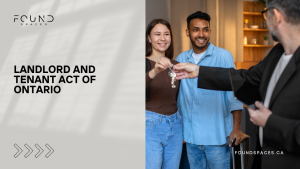Disputes under the Ontario Residential Tenancies Act (RTA) should begin with clear communication. Speak directly with your tenant or landlord and follow up in writing to keep a record. It’s important to understand whether the issue is an offense under the Act or a general disagreement, as this affects the steps you’ll take next.
For serious violations, like shutting off utilities, contact the Rental Housing Enforcement Unit. For issues such as unpaid rent or maintenance concerns, you’ll likely need to file an application with the Landlord and Tenant Board (LTB). The board typically offers mediation first, followed by a hearing if necessary. To navigate the process effectively, stay organized, meet all deadlines, and keep thorough records.
Start with Clear Communication

When a problem arises, address it directly and calmly with your tenant or landlord. A respectful approach can help prevent the situation from escalating.
Use written communication, emails or letters to explain your concerns. This creates a record of the issue. Clearly state the facts, include relevant dates, and outline what resolution you’re seeking. Save copies of all correspondence and note the date and time of any verbal conversations. Ask for confirmation or a response to ensure your message has been received.
Avoid using threats or ultimatums at the beginning. Focus on the issue and keep your messages concise to limit misunderstandings. Keeping a log of all interactions, whether by phone, in person, or in writing, can be helpful if the dispute moves to a formal process.
Identify the Nature of the Dispute
Before taking formal action, determine what kind of dispute you’re dealing with. RTA violations such as harassment, illegal entry, or utility shutoffs can be reported to the Rental Housing Enforcement Unit. Other matters, like unpaid rent or disagreements over repairs, are usually handled by the LTB.
Distinguish between urgent issues, such as safety concerns or utility interruptions, and less pressing ones. Refer to the RTA guidelines or contact the Enforcement Unit to clarify whether your situation qualifies as an offense. Some disputes may fall into both categories and involve multiple steps.
Knowing what you’re hoping to achieve—whether it’s a repair, payment, or another outcome—will help guide your approach. If the situation is complex, it’s a good idea to seek legal advice early.
Report Offences to the Rental Housing Enforcement Unit
If you believe an offense has occurred, contact the Rental Housing Enforcement Unit by phone or through their online portal. When submitting a complaint, include your contact information, details of the other party, and a clear description of the issue, with specific dates and events.
Supporting documents such as emails, photos, written notices, or witness statements, can strengthen your complaint. The Unit may try to resolve the issue informally, but they also have authority to issue orders, impose penalties, or take legal action if needed.
Keep a record of your complaint, any reference numbers, and all related communication. Follow up if you don’t receive a response within a reasonable timeframe. Note that reporting an offense doesn’t prevent you from also pursuing the matter through the LTB.
Filing Complaints with the Rental Housing Enforcement Unit
Before submitting your complaint, gather all relevant documents. This might include lease agreements, notices, and records of previous communication. When completing the complaint form, be clear and accurate. Include evidence that shows you’ve attempted to resolve the issue on your own.
Make sure your contact information is current so the Unit can reach you if needed. You can submit your complaint by phone, email, or through the official website. Ask for confirmation and a case number to help track your file.
Investigations can take time depending on the complexity of the issue. Be honest and precise to avoid delays or dismissal. Keep your tone professional in all communication. If problems continue after you’ve filed a complaint, document any new developments. These may be important if further action is required.
Using the Landlord and Tenant Board for Dispute Resolution

If a dispute under the Ontario Residential Tenancies Act can’t be resolved directly, the Landlord and Tenant Board (LTB) provides a formal process to help settle it. Start by selecting and completing the correct application form for your situation, such as the N4 for rent arrears. You’ll need to pay the application fee unless you qualify for a fee waiver, then submit the form online, by mail, or in person, following LTB instructions.
Once your application is submitted, the LTB may offer mediation to help both sides reach a voluntary agreement. To prepare, gather relevant documents, organize your facts, and be clear about the outcome you’re seeking. If mediation fails, the case will proceed to a formal hearing where you’ll present your case with evidence and witness testimony, if applicable. Hearings may be held in person, by phone, or by video conference.
After the hearing, you’ll receive a written decision from the adjudicator. This outlines the ruling and any steps you must take. It’s important to follow these instructions carefully, including meeting deadlines or filing an appeal if necessary, to protect your rights.
Steps to Prepare and File Your LTB Application
Before filing your application with the Landlord and Tenant Board (LTB), start by carefully reviewing the LTB website or their official guide to find the correct form for your specific dispute. Using the wrong form can delay your case or cause rejection. Gather all relevant evidence such as your lease agreement, rent payment records, photos of any damages or issues, and copies of written communications. This documentation strengthens your claim and supports your position clearly.
Next, write a straightforward explanation of your complaint or claim. Keep it concise and focused on the facts so the LTB can quickly understand the nature of your dispute. Make sure to check the deadlines for filing your application since missing these can mean losing your chance to have the matter heard.
When completing the application form, provide accurate and complete details about both parties and the dispute itself. Double-check names, addresses, and dates to avoid errors that might cause delays. You will also need to calculate and pay the required fee, or if you qualify, submit a request for a fee waiver to avoid unnecessary costs.
Make copies of your completed application and all supporting documents before submitting them through the official LTB channels, which may include online submission or mail. After filing, keep confirmation receipts or emails as proof that your application was received.
While waiting for the LTB to schedule mediation or hearing dates, organize your evidence and review your case thoroughly. Being prepared ahead of time helps ensure you can present your case effectively when the time comes.
How Mediation Works at the LTB

Mediation at the Landlord and Tenant Board (LTB) is a voluntary and confidential process where a neutral mediator helps both landlords and tenants communicate and explore possible solutions. Unlike a formal hearing, mediation sessions are informal and focus on finding a mutually acceptable agreement. Both parties must agree to participate; mediation cannot be forced.
You can bring any supporting documents to help explain your position, but formal rules of evidence do not apply, making the process less intimidating. Typically, mediation is scheduled soon after you file your application, which means you could resolve the dispute faster and with less stress than going straight to a hearing.
If an agreement is reached, it is recorded and becomes a binding order that both parties must follow. However, if mediation doesn’t lead to a resolution, the dispute will proceed to a hearing where a formal decision will be made. To prepare for mediation, it helps to know your priorities and consider what compromises you’re willing to accept, so you can negotiate effectively and increase the chances of settling the dispute early.
What to Expect at the LTB Hearing
An LTB hearing is a formal session where both sides present their case to an adjudicator. You may attend in person, by phone, or through video. Bring all relevant evidence, such as lease agreements, photos, emails, and payment records, and be ready to explain your position clearly. Witnesses can also be helpful.
Both parties will have a chance to respond to each other. The hearing is recorded, and the adjudicator will issue a written decision afterward. This decision is legally binding and includes any actions you must take, along with important deadlines.
Being punctual, organized, and respectful helps the hearing go smoothly. For instance, if a landlord presents evidence of missed rent payments, and the tenant provides proof of payment, the adjudicator will weigh both sides before deciding. Understanding how the hearing works can help you stay focused and increase your chances of a fair outcome.
Following Up After the LTB Hearing
After the Landlord and Tenant Board (LTB) hearing, it’s crucial to review the written Order carefully to fully understand the adjudicator’s decision. It’s informal and doesn’t follow strict legal procedures. Both parties must agree to participate, and each can bring documents to help explain their side.
Mediation usually takes place shortly after you file your application, offering a quicker and less stressful resolution than a formal hearing. If an agreement is reached, it’s recorded and becomes a binding order. If not, the case moves to a hearing.
To make the most of mediation, be clear about what matters most to you and what compromises you’re willing to make. This can improve your chances of reaching a fair outcome.
How Found Spaces Supports You Through Disputes
Found Spaces handles all tenant communications to keep disputes contained and professional, preventing escalation. Our team carefully documents every step of the dispute process, creating a clear record that supports your case. We start by identifying whether the issue involves an Ontario Residential Tenancies Act offense or a general disagreement. For offenses, we take on the responsibility of coordinating complaints with the Rental Housing Enforcement Unit, saving you time and ensuring proper follow-through.
When disputes require action at the Landlord and Tenant Board, we prepare and file applications accurately and on time to avoid delays. We also manage mediation sessions to seek fair and quick resolutions without the need for formal hearings. If mediation does not resolve the matter, we represent your interests at Board hearings, presenting organized evidence and supporting witness testimony.
After hearings, we interpret LTB orders clearly and guide you through the necessary compliance or enforcement steps. Throughout the process, we provide clear updates so you are never left in the dark. Our experience handling legal and procedural details reduces your stress, letting you focus on your property while we manage the complexities of dispute resolution.
Ready to Simplify Property Management? Book a Call Today
Scheduling a consultation with us is the first step toward easing your property management challenges. During the call, you’ll get a clear overview of how we handle tenant disputes and legal issues under Ontario’s Residential Tenancies Act. We’ll explain our step-by-step approach to communication, enforcement, and resolution so you know exactly what to expect.
Our professional services are designed to save you time and reduce stress by managing everything from documentation and rent collection to maintenance requests. You’ll receive personalized advice tailored to your specific property needs, ensuring solutions that fit your situation. We also offer flexible service plans to match your budget and goals. Feel free to ask about how we keep you informed with regular updates and transparent reporting. Taking this step helps protect your investment and makes property management simpler and more efficient.
Want a quick reference to keep on hand? Download our free Landlord Dispute Resolution Cheat Sheet—a handy one-pager that breaks down your options under Ontario’s Residential Tenancies Act, with links, tips, and key steps.
Frequently Asked Questions
1. What steps can a tenant take if the landlord is not fixing essential repairs according to the Ontario Residential Tenancies Act?
If a landlord fails to make necessary repairs, a tenant should first notify them in writing and keep a copy. If the issue remains unresolved, the tenant can file an application with the Landlord and Tenant Board to request an order for repairs or rent reduction.
2. How does the Ontario Residential Tenancies Act handle disputes over rent increases that a tenant believes are unfair?
Tenants can challenge rent increases they consider unjust by checking if the increase complies with the legal guidelines set annually. If a rent increase is above the allowed amount or not properly notified, tenants may file an application with the Landlord and Tenant Board to dispute it.
3. What happens if a tenant wants to end a lease early due to unsafe living conditions under the Ontario Residential Tenancies Act?
If living conditions are unsafe and not addressed, the tenant should document the issues and notify the landlord. If the problem persists, tenants can apply to the Landlord and Tenant Board to terminate the lease early without penalty.
4. Can a landlord legally enter a tenant’s unit without permission, and what should a tenant do if this happens?
Under the Act, landlords must give at least 24 hours written notice before entering, except in emergencies. If a landlord enters without proper notice or consent, the tenant can report the breach and may file a complaint with the Landlord and Tenant Board.
5. How can tenants and landlords resolve disputes related to noise or disturbances without going to court?
Many disputes around noise or disturbances can be resolved by communication or mediation. Tenants can document incidents and try discussing the issues with the landlord or neighbor. If that doesn’t work, either party can seek help from community mediation services or file a complaint with the Landlord and Tenant Board.




